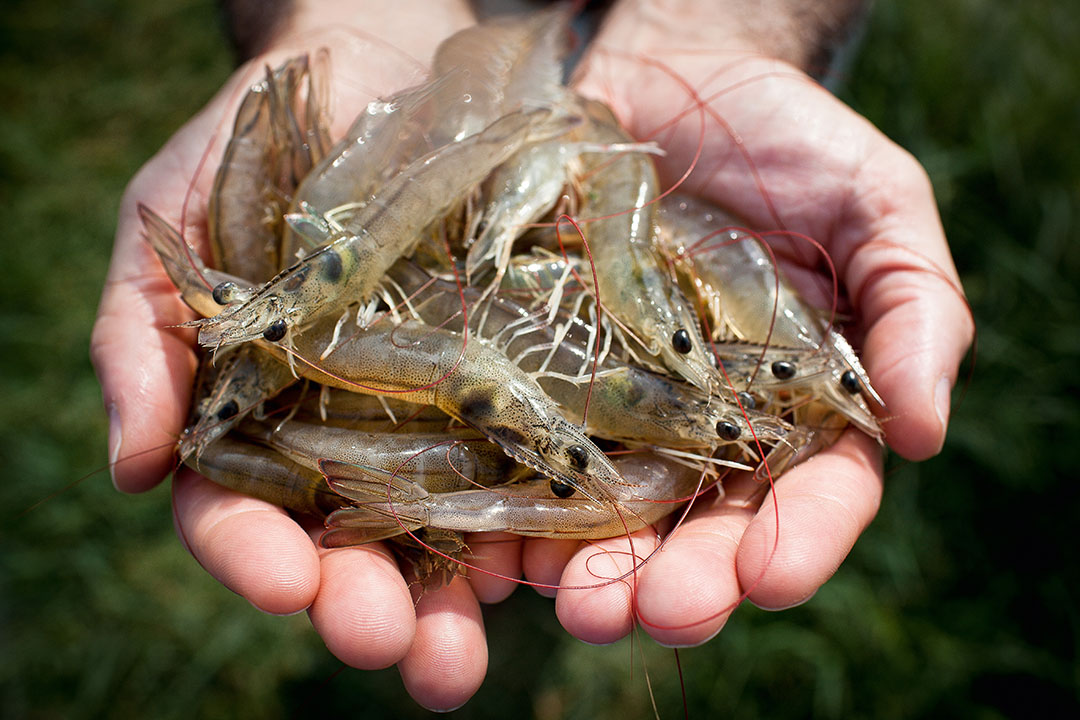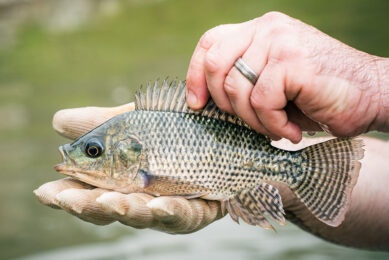Reducing early impact of WSSV in shrimps

White Spot Syndrome Virus (WSSV) is a major shrimp pathogen, present in most of the producing regions and causing considerable economic losses to farmers. A new feed solution however showed strong reduction in mortality and improvement of growth in moderate WSSV pressure.
White Spot Syndrome Virus (WSSV) is a dsDNA virus of the Nimaviridae family affecting all Penaeid shrimps. This enveloped virus leads to high mortality in shrimp farms all over the world and is highly contagious. WSSV characteristically causes small white spots to appear on the inside surface of the cuticle, carapace and appendages, supposedly being the result of a dysfunction of the integument, leading to an accumulation of calcium salts in the cuticle.
The epithelium of the gills, integument and the stomach are the most severely damaged and the related dysfunctions lead to death in the last stage of the infection. Other clinical signs include a loose cuticle, a sudden reduction in feed consumption and lethargy. Common routes of infection are through contact with infected tissue, cannibalism and by water-borne routes. It can also be vertically transmitted to offspring. Once the virus has reached a threshold concentration, the outbreak is extremely rapid, forcing farmers to carry out emergency harvests. Therefore, early detection of the virus by quantitative or nested PCR as well as improving the immune system of the host and decreasing the development of the virus is of primordial importance.
Annual loss of one billion US dollars
First reported in 1992, its rapid expansion throughout all shrimp production regions makes it one of the main pathogens in the shrimp industry. Total losses for this virus alone have been estimated to be in the range of US$ 1 billion per year since the middle of the 1990s. The spread of WSSV over the years has hampered the development of shrimp farming in many tropical areas, which cut smallholder farmers from a new source of income. Researchers are therefore very much focused on finding solutions that can reduce the mortality rates, caused by the diseases. The nutritional supplements that are being developed for shrimp are often targeted at improving the immune function and/or improving the gut health of the animals.
This suits well with the non-antibiotic approach seen in aquaculture, followed by the global trend in other livestock sectors as well to reduce antibiotic use. One of the in-feed solutions that has been developed is a patented Copper-exchanged Clay (CeC). This product is based on an ion activated clay, aiming at securing digestive process. CeC acts as a microflora modulator in the gut, thus helping monogastric animals to face challenging periods. As demonstrated in scientific literature (CAI-HONG et al, 2006) CeC combines the technical properties of a clay and copper. Copper compounds such as CuSO4 are one of the traditional inorganic antibacterial materials with a wide usage. However Cu2+ ions are difficult to connect with bacteria. Thanks to the specific layer structure of the clay, the cations present between the structure sheets can be readily replaced by other cations or compounds such as bacteria. The clay also serves as a carrier of the coper in the intestinal lumen.
Figure 1 – Evolution of the survival rate (%) of L. vannamei shrimps.

Trial in field conditions
A WSSV-infection trial was carried out at Incabiotec ConceptoAzul facilities in Peru, applying a mild WSSV challenge to L. vannamei juveniles during six weeks in 15 litre tanks containing 100 PostLarvae/tank. Two successive inoculations were performed, first at week one (stage PL26), and then at week four with an inoculum prepared from a biomass of live shrimp that were infected with WSSV and positive for WSSV at second PCR, in order to mimic field conditions in which the virus progressively develops in the pond. The inoculums were frozen in order to kill bacteria content. 1 mL of the inoculum was placed in each tank. Viral concentration of the inoculation solution was analysed by qPCR and detection of pathogenic agents was recorded on 10 dead PL/group by nested PCR to assess correct contamination of shrimps. Three groups were implemented: negative control group (no inoculation), positive control group (WSSV inoculation) and CeC group (WSSV inoculation and 5 kg/ton CeC in the feed). CeC group was fed with CeC two weeks prior infection and during the whole challenge period. Each group was replicated three times. Survival rate and average body weight (ABW) were monitored after the six weeks trial period.
Results
Dead shrimps were positive at the second PCR analysis, demonstrating that the operated challenge mimics real field conditions in which the virus develops slowly and is lethal to weaker animals, thus gradually building-up its infectious pressure in the shrimp population. Table 1 and Figure 1 illustrate the survival rates of the three different groups. The group fed with CeC showed a survival rate 15 points higher than in the positive control group, meaning +19.8% of the shrimp population. CeC significantly improved survival of shrimps, even in comparison to the non-inoculated control group (+10.6%). An estimation of live weight was done on one replicate per group in order to calculate the biomass evolution during the trial. Figure 2 illustrating the biomass evolution, suggests that shrimps fed with CeC had a higher growth (+102%, so two-fold weight compared with the WSSV inoculated group).
Figure 2 – Evolution of the biomass (g/tank) of L. vannamei shrimps.

A promising solution
The positive results observed in this study suggest that copper exchanged clay (CeC) is an effective solution to reduce the development of WSSV in its early stage, thus strongly helping to prevent WSSV general outbreaks in shrimp populations. A significant higher survival rate was observed, associated with a beneficial effect on growth of juvenile shrimps, which tend to confirm the protective effect of CeC. CeC aims to secure the digestive process by improving the intestinal microflora balance and consequently improving the integrity of the epithelial barrier. The pathogen’s pressure from bacteria can be reduced, which allows enhanced animal performance and limits the negative effect of virus infection. These preliminary results are very encouraging in terms of prospects in a wide range of shrimp farms, given the worldwide distribution of WSSV; further investigations are already in progress.
References are available on request.











